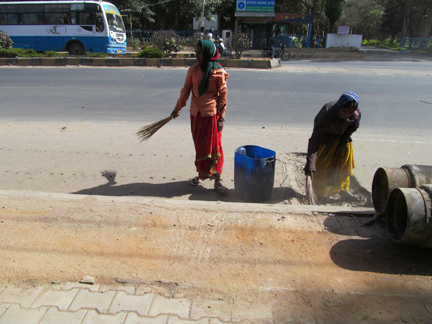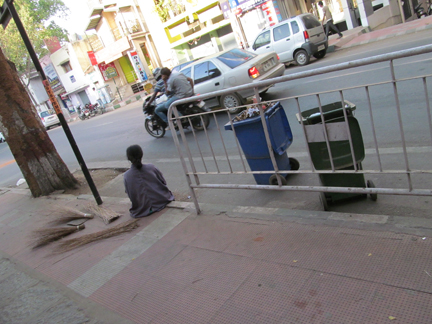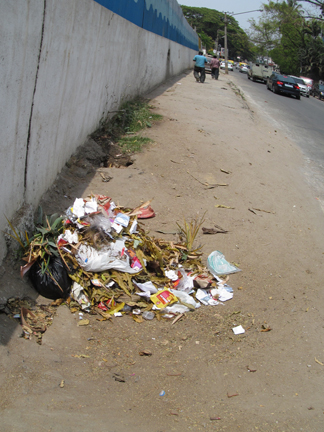David Stairs
“Indians do not have the same civic sense as, say, Scandinavians. The boundary of the space you keep clean is marked at the end of the space you call your own.”
—from Maximum City by Suketu Mehta

The Commons are a topic of concern to contemporary Indians. Whether talking about road safety or land usage, the pressures of exploding population upon available resources stand front and foremost in discussions of continuing Indian success. Growth has its costs, not least the waste products of hordes of people.
The founders of The Ugly Indian are a group of anonymous volunteers dedicated to cleaning up the streets of Bangalore. Design-Altruism-Project spoke to some of the founding members of TUI recently about this initiative and what it hopes to accomplish.
D-A-P: I’ve watched school boys walking together all drop papers to the ground simultaneously, as if it was a group ritual. Why are Indians so indifferent about the commons?
TUI: I have not come across a ritual like that so far. But I guess kids may have found a game in throwing the pieces of papers or wrappers!
‘To litter in public spaces’ is common practice here, which is an outcome of social acceptance of ‘Normalcy’ of sorts. When we see others throwing garbage/trash in open or public spaces and not facing any objections, it tells us that it is okay to litter. It becomes ‘normal’ to litter. Walking on the road rather than footpath, jumping lanes and signals while driving; all follow the same logic.
In India caste-class-religion has an influence on all our behaviors, especially in public spaces. Hence, nobody wants to risk himself/herself by taking a stand on right or wrong in trivial matters. In the matter of commons, we just adjust ourselves safeguarding our own interests.
In our representative democracy our leaders get elected on the caste-class-religion vote banks. And to stay in power they too keep negotiating on rights and wrongs. They fail to take stands on social issues and even if they did they would not get enough support from other parties and public. Even if elaborate laws are drafted, due to politics and vested interests implementation is poor and strict enforcement is a rare case.
You never know, in India by doing something other than ‘Normal’ what you will land up in. Hence we ‘the Indians’ only rely on peers and mass behavior to act upon the ‘rules and regulations’.

D-A-P: Everywhere I see street sweepers doing small jobs, but they can’t possibly keep up with demand. Can’t the City site more dumpsters and remove them when full?
TUI: Sweepers in Bangalore are one of the rare groups of government employees who are hard-working and diligent. Being at the bottom of hierarchy they are under paid and over exploited.
If you visit the streets in Bangalore around 9 am, you will find that the public spaces and streets are quite clean. Sweepers are doing their job well… and yet streets get very dirty in no time. Around 10:30 shops open and house keeping staff (read as ‘keeping house clean by throwing unwanted things out of the house’) start their work of dumping garbage on streets as they miss the door-to-door pickup time OR they find it convenient to dump their garbage at some ‘orphan’ sites in the vicinity.
Back in 2004 a ‘No-Bin’ policy was implemented for the first time in Bangalore. All the community dumpsters were removed, so the only option left to the public was to use the door-to-door pickup service. But due to capacity and timing issues, the garbage started getting dumped in neglected sites. And yet I would say this decision of removing dumpsters has helped Bangalore look cleaner than other cities in India. Elsewhere community dumpsters and surrounding areas are found to be extremely filthy, and mostly overflowing. Such eye-sores did get eliminated by the No-Bin policy. As overall dependency on the daily door-to-door pick-up system increased, the clearing staff became directly answerable to the user, thus raising regularity in garbage clearance.

One of the main reasons for ‘dumping in open’ practice is that the policy doesn’t designate any role or responsibility to those who dispose garbage. An elaborate system is present that collects the garbage from streets, residents, commercial establishments, public places and hospitals, then duly disposes that garbage at the designated locations; but the other half of the system, the users side, is missing. To co-ordinate the timing with the door-to-door pickup one has to park the garbage somewhere. People face inconvenience here and thus dump garbage at any more convenient place. To make the door-to-door pickup system successful, parking of garbage at designated sites is essential. It should even be made mandatory for all residential and commercial establishments. The garbage parking space and containers’ capacity should be standardized and approved by the garbage disposal monitoring service as per the usage patterns and number of people using it.
High-volume seasonal and occasional waste also needs a clearance system in place. Renovation and repair waste like rubble-ceramic waste, hazardous waste such as tubelights, glass, thermacol etc., and flora used in festivals and in temple prayers all need a system for clearance. Even garden cuttings and seasonal leaf fall need to be picked up, perhaps separately and systematically. Manned dumpsters may help in this. But in the current situation, where the mafias run garbage disposal systems and do not even allow other contractors to bid for garbage cleaning and disposal contract, it is hard to imagine any major changes in current disposal practices.

D-A-P: In the ’60’s America used a native American with a tear on his cheek as an anti-litter symbol. Have you considered creating a similarly powerful local icon?
TUI: Signs and symbols will hardly be of any use unless there is presence of essential facilitation, such as litter-bins, in sufficient quantity and at strategic locations, so that a maximum number of people can use it.
Filth and dirt in public spaces is a well-known, highly visible problem. What is required at this point of time is to design clever ways —nudges— to change social behaviour. And that needs provision of essential facilitation, through litter-bins, urinals, etc.
Once the new ‘normal’ is established at a ‘critical mass,’ different icons can be designed to promote or fuel the movement and to reach the masses. But I doubt that can happen on a national scale.

D-A-P: Is it ultimately possible to promote public hygiene by example or do laws need to be strengthened?
TUI: The Ugly Indian’s objective is to make the public spaces clean and neat, and to enhance the experience of public spaces. We are more concerned about the look and feel of these spaces and the embarrassment they cause to all of us. We don’t have much experience in solving issues regarding public hygiene and environment. India has elaborate and detailed laws, but their enforcement is poor.
D-A-P: You are doing great work. How do you see The Ugly Indian expanding?
TUI: ‘The Ugly Indian’ is an initiative which showcases ways to keep neighborhoods clean and neat. It provokes citizens to take ownership of the problem and empowers them to solve it. Greater numbers of people coming forward and solving the problems in their own neighborhoods is what we consider as success. Being highly active on facebook and youtube, our message is reaching many across the world. It’s already expanding on its own. But we, as a core group, want to stick to Bangalore and utilize it as a lab to present to the world ‘a proof of concept’. We would like to solve different visible problems and issues in public spaces which ruin the look, feel and experience of public spaces.
David Stairs is the founding editor of Design-Altruism-Project











Leave a Reply
You must be logged in to post a comment.